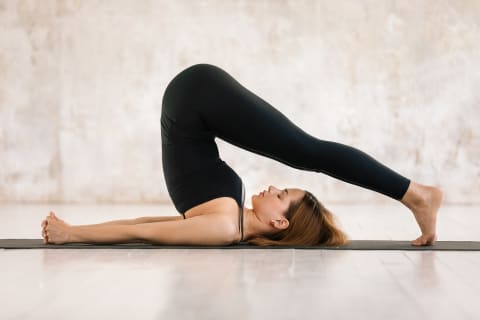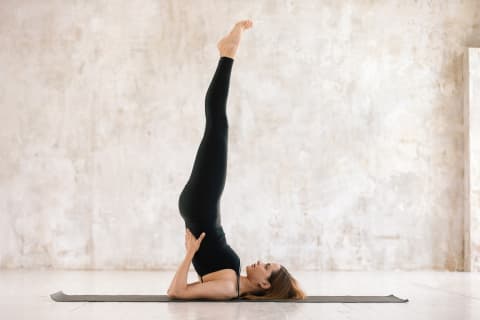Advertisement
Shoulder Stand: 6 Benefits Of This Yoga Inversion + How To Do It Safely

Known by many yogis as “the queen of all yoga poses,” shoulder stand is an advanced posture that—while very beneficial for your body and mind—can take time and patience to master. Here's exactly how to do this inversion the right way, and some expert-approved modifications and top tips. Consider this your complete guide to shoulder stands—you'll be practicing this impressive pose in no time.
6 benefits of shoulder stand.
Shoulder stands don’t just look impressive—they can also improve everything from your strength to your circulation. Below are the biggest benefits to doing shoulder stands, according to science.
Increases circulation.
Inversions—like shoulder stand—can reverse your blood flow so that when you stand back up, a fresh wave of blood shoots through your body. Experts have researched how this rush revs up your circulation and brings more oxygen into your entire body.
Builds strength and flexibility.
Lifting into—and holding—shoulder stand requires a lot of core strength along with upper body strength. It also increases the range of motion and flexibility in your neck and shoulders and can even strengthen your legs and back muscles as your entire body is engaged during the posture.
Can improve digestion.
According to experts, being upside down readjusts your internal organs like your intestines and colon. That, in turn, can stimulate bowel movements and clears up your digestive system (which can be perfect for people struggling with constipation or IBS!).
Can enhance your lymphatic system.
Your lymphatic system influences a variety of major conditions in our bodies—it helps rid your body of waste and fight off infections, inflammation, and metabolic diseases1. By getting into shoulder stand, the reverse of gravity can allow lymph to move towards other organs, which can help flush your whole lymphatic system. This can speed up waste removal and give your lymphatic system a much-needed refresh.
“Remember: While the lymphatic system is a circulatory system like the blood vessels we all have, there is no heart to drive the lymphatic system, so we have to move and exercise to make the lymph flow nicely,” Integrative Gastroenterologist Marvin Singh, M.D., has previously told mbg. And inversions like shoulder stand can help stimulate the flow of lymph in a different way than we might be used to, which can help maintain fluid balance in our bodies.
Can relieve stress and anxiety.
Being in a shoulder stand (i.e. a pose where your heels are above your heart) calms your parasympathetic nervous system, which helps your body and mind feel much more relaxed. One study even found that students who practiced two hours of yoga—including inversions like shoulder stands—a week for five weeks showed a significant decrease in depression and anxiety symptoms2.
Can reduce fatigue.
When your heart is above your head, more blood—and more oxygen—are flowing to your brain. This makes you feel more energetic and alert (i.e. it can help combat the drowsiness that comes with your 2 p.m. slump). Not only that but research has found daily yoga to reduce insomnia3 and help you get a better night’s sleep.
How to do a perfect shoulder stand.
First things first: Always warm up your muscles before trying an advanced posture like shoulder stand. “Warm up properly before you attempt this, especially your spine, hamstrings, shoulders & neck,” says yoga instructor Paris James, B.Sc., RYT-200. “If these areas are tight, they will pull and you might feel discomfort or worse, injure yourself.”
You also want to make sure you find proper alignment before starting. "You want to make sure your head, neck, and shoulders are safe," says yoga instructor Caley Alyssa in our Yoga Inversions 101 class.
When you’re ready, make your way to legs up the wall pose. Extend your legs straight up towards the sky and flex your toes back towards your face. Lay your arms down by your sides with your palms pressed into your mat.
You can then move into your plow pose:

Lift your lower back off your mat as you bring your feet up and over your head, resting your toes on the ground behind you and pushing through your heels.
Once this feels comfortable, tuck one knee and then the other into your forehead, creating a small ball with your body.
Then, press your feet up towards the ceiling into your shoulder stand:

Keep your neck long while tucking your chin into your chest. Avoid “launching” yourself into the position—move slowly and controlled instead. James recommends placing your hands on your hips or lower back or interlacing your hands on the mat (in the opposite direction of your legs) to provide more support and stability.
Don’t forget to breathe, either. “I can’t stress this enough,” James urges. “I’ve seen students constrict or hold their breath in this and feel an immediate tightening of their chest. Just relax, don’t resist the stretch, and breathe.”
To come out of shoulder stand, gently lower your legs back to plow pose. "You can pike down with both legs or you can come down with one leg followed by the other," Alyssa says. From plow, you can bend your knees and breathe, then when you're ready, slowly release your hands from lower back and roll back down onto your spine.
Modifications and tips.
If you want the benefits of a shoulder stand but aren’t quite there yet, there are a few modifications you can make to make the pose more accessible.
First, you can put a blanket underneath of your shoulders or a block underneath of your sacrum for extra support. "Align your shoulders with the end of the blanket so your head and neck come off of the edge of the blanket," Alyssa explains.
If you aren't so comfortable while in the shoulder stand pose, you can bend one knee into the chest and breathe before switching. "It will help you feel a little more stable and grounded," Alyssa continues.
James also recommends using a wall. “Face the wall and keep crawling or edging your legs up until you can find your balance here when you remove your legs,” she explains.
Whether you’re an advanced yogi or a beginner, there are a lot of benefits to incorporating shoulder stand into your regular yoga practice. Start with the tips above and remember: The more you practice, the easier it will become.